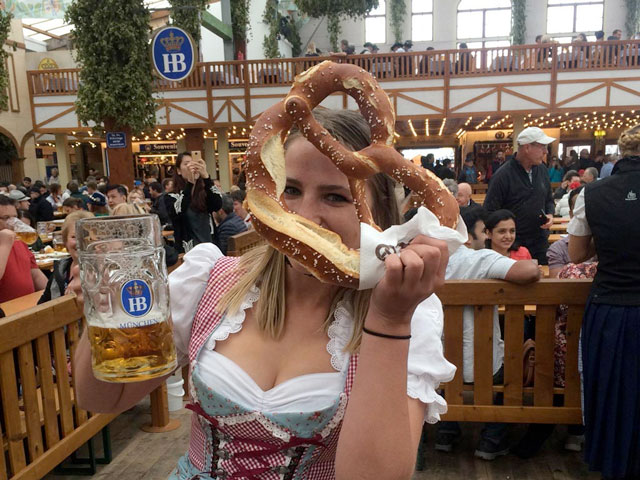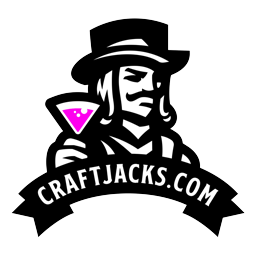Everything to Know About Oktoberfest
No doubt, just hearing the name Oktoberfest conjures up images of lederhosen wearing tourists drinking German bier (beer) and eating strudel, but it’s much more than that. Well, maybe not much more.
Written by CraftJack | Updated | 6 min read
Interesting Tools
- Beer BrüMate Hopsulator
- Brewing Northern Brewer Beer Making Kit
- Spirit Crystal Whiskey Glasses
- Wine Wine Decanter/Aerator

This over two-hundred-year-old folk festival has a rich history that spans two world wars and numerous changes in German culture. For just over two weeks, Oktoberfest gives a sense of welcome or, in German, willkommen for both locals and tourists. People come together for food and drink and return for Gemütlichkeit, defined as the state of warmth, friendliness, and good cheer they feel there.
Check out our favorite Oktoberfest beers.
Table of Contents
What is Oktoberfest?
Oktoberfest is an annual 16-18 day German beer festival and fun fair held in Munich, Bavaria, Germany. In short, it's a two week bender in another country (if you're American like most of the readers here).
From 1810 onward, the festival, which runs from mid or late September to the first Sunday of October, draws millions of people worldwide to Munich to consume German beer, watch parades, eat pretzels and listen to live music. What began as a royal wedding celebration has now transformed into something known throughout the world and celebrated in countries around the globe.
Although Oktoberfest is best known for German beer, it’s not the only beverage available. There are plenty of alcoholic options sold in large amounts. On the lighter side, there are fizzy radlers made of half-light beer and half fizzy lemon soda, plus, wine, schnapps, and other alcohol-laced drinks like Irish coffees.
Speaking of coffee, vast quantities of coffee and tea are consumed during the festival, as well as alcohol-free beer.
As for anything harder, let's just say that no one is ordering Jack & Cokes. It's a feast, not a quiet night sampling Scotch, no one will be ordering a whiskey neat.
Oktoberfest Celebrations Outside of Munich
Thanks to the success of Oktoberfest and its long-running history, the festival’s spirit has traveled with immigrants as they left Germany and moved around the world. They founded Oktoberfest-inspired celebrations with German beer and traditional German food that they then passed to their descendants in their new homes.
In Canada, the largest Oktoberfest outside of Germany happens each year, bringing in 700,000 people for Oktoberfest in Kitchener, Ontario, and the surrounding area. Hopefully the drink a ton of Puppers Beer up there in Ontario, cause that would make for a cool Canadian Oktoberfest. Other celebrations happen throughout North America, South America, and as far as Australia and Asia.
History of Oktoberfest
The first Oktoberfest looked very little like the Official Oktoberfest that happens today. Instead of a fair with rides and stalls, the first Oktoberfest was a horse race to celebrate King Ludwig I and Princess Therese of Saxony-Hildburghausen.
Fun fact - Germany's Weihenstephaner is the oldest brewery in the world. So, you could say there is a rich history of brewing beer in the country.
1811 - Agricultural Beginnings
However, naturally, after the first Oktoberfest, which was a huge success, the residents of Munich wanted another beer festival, but there was no royal wedding as a reason to have one. Thankfully, the Bavarian agricultural association stepped up as the new organizers to create something like the Oktoberfest that we see celebrated today.
They included a stall celebrating agriculture and introduced activities for the whole family, a trend that continues today on a grander scale.
1819 - Munich Financing
After events during the Napoleonic Wars that caused it to be canceled, Oktoberfest was privately financed until it was later made a priority by the city in 1819 and became part of its annual budget. Not having to rely on an association or private financier every year meant that the city of Munich could invest in every aspect of the festival, from the grounds to promoting brewers all year long.
Oktoberfest has consistently occupied the Theresienwiese, and over time the area used has grown to the large area used today.
One of the features of these grounds is the statue of Bavaria, considered to be the guardian angel of Oktoberfest, unveiled in 1850. This statue alongside the Hall of Fame helps mark out one of the boundaries of the festival grounds.
Late 19th Century - Hot Food, Electricity, Live Music
The late 19th century brought many innovations to Oktoberfest. Famously, the first hot food to be paired with beer were roast chicken tents. Following that were the bratwurst stalls that arrived in 1881.
It was only a year earlier, in 1880, that they incorporated electricity so the tents and stalls could operate with electrical lighting, allowing bigger brewer tents and live music for a backdrop to the Wiesn festivities.
In 1887, the first parade consisted of Brewery and Oktoberfest staff with finely decorated horses. This parade tradition has continued on the first Saturday of Oktoberfest every year since.
World War I and World War II
War is one of the main reasons for Oktoberfest’s cancellation, specifically, World War(s). During World War I, from 1914 to 1918, Oktoberfest was temporarily suspended and then replaced by a smaller autumn festival in 1919 and 1920. The hyperinflation and increased prices in 1923 and 1924 also resulted in cancellation.
From 1939 to 1948, Oktoberfest was canceled, and only Autumn Fest replaced it from 1946 to 1948. During this time, stronger beer was banned, and guests could only drink regular strength beer during the Autumn fest.
1980 - Bombing at Oktoberfest
On September 26, 1980, a bomb made of an emptied fire extinguisher, over a kilogram of TNT and mortar shells exploded at the main entrance to Oktoberfest. The resulting explosion killed 13 people, including the bomber Gundolf Köhler although the case was reopened in 2014 and injured over 200 more.
2005 - Modern & Quiet Oktoberfest
Many of the early traditions of Oktoberfest, such as parades, hot food, and beer, have remained to this day, and others have changed to fit the times. Quiet Oktoberfest is a tradition instituted in 2005 to encourage more families to attend. Live music is required to be only Bavarian Brass band music until 6 pm.
No tent or hall may play anything other than brass band music until that time, but after that, “tents may play party music” such as pop or electronica.
In 2010, the 200th anniversary of Oktoberfest was held with a historic Oktoberfest to tell attendees about the history and included reenactments and horse racing. Locals call it ‘Oide Wiesn’ and have held it every year since.
Types of Beer Served
Tents can serve only Oktoberfest beer during the festival, and it must meet a few rigorous criteria before it can be classified that way. To be served on the Theresienwiese (d’Wiesn to the locals) during Oktoberfest, it must be brewed in Munich and conform with Reinheitsgebot.
Currently only six Munich breweries, known as the Club of Munich Brewers meet the requirements to call their beer Oktoberfest beer:
- Augustiner-Bräu
- Hacker-Pschorr-Bräu
- Löwenbräu
- Paulaner
- Spatenbräu
- Staatliches Hofbräu-München
Traditionally Oktoberfest beer comes in two styles: a Märzen lager and a lighter and a paler Festbier, but it’s up to the individual brewery to make their own decision each year. These breweries will release their own Oktoberfest offering, often teasing their beers months before the event.
Regardless of the brewery chosen or the beer style, learning to say ‘Prost!’, which in German means Cheers!, will come in handy. Also, hold your beer glasses by the handle. It's the right thing to do.
Beer Prices
The price of beer is usually made available to the public by the city of Munich in June. For Oktoberfest 2021, the price was expected to be $12-12.50€ per liter.
Beer Strength
Hofbräu, at 6.3% ABV has the highest alcohol content of the Oktoberfest beers. Hacker Pschorr is the lowest. The rest have an alcohol by volume rating in-between those two.

Dress
Traditional Bavarian clothing is common to wear at Oktoberfest. This includes dirndls, lederhosen, brass bands, Alpine hats, big socks, white button up shirts, and the like.
Festival Size
Over 7.2 million people visited the festival in 2019, consuming 6.9 million liters of beer in the numerous beer gardens and approximately 280,450 bratwursts. That's even more pints of beer than Guinness served on St. Patrick's Day.
The extensive Theresienwiese grounds cover 420,000 square meters allowing seating for 100,000 people and helping to make Oktoberfest the largest folk festival in the world.
Dates
Oktoberfest always runs roughly the same time each year for approximately two weeks and concludes on the first Sunday of October. However, certain events can prolong festivities.
These traditional dates will change if a public Holiday such as Reunification Day falls on the Monday or Tuesday after the first Sunday of October, in which case Oktoberfest may be one or two days longer.
Oktoberfest 2021 was cancelled for the first time in a long, long time. Promoters will look toward 2022 when it will resume again on Saturday, September 17th.
Future Dates of Oktoberfest:
- 2022 Dates - Saturday, September 17th until 10:30 pm on Monday, October 3rd.
- 2023 Dates - Saturday, September 16th until 10:30 pm on Tuesday, October 3rd.
- 2024 Dates - Saturday, September 21st until 10:30 pm on Sunday, October 6th.
- 2025 Dates - Saturday, September 20th until 10:30 pm on Sunday, October 5th.
Tents
Like many outdoor festivals, Oktoberfest comprises many tents and halls to shelter people from the elements and provide seating. As of 2019, there were fourteen large tents and twenty small tents situated on the grounds at the Wiesn.
The tents are usually wooden, non-permanent, and are constructed specifically for use during the festival. Each of these tents provides different offerings in the form of food, drink (hint: kegs of beer), and entertainment.
Large Tent Summary
Each of the large tents in the biergartens (beer gardens) features a brewery, music, and sometimes food. Repeat visitors will soon come to know tents by their lavish decorations or specialties as often the same tent will appear in the same spot year after year.
| Tent Name | Brewery | Special Notes |
|---|---|---|
| Marstall | Spaten-Franziskaner-Bräu | First tent visitors see Band: Münchner Zwietracht |
| Armbrustschützenzelt | Paulaner | Part of Oktoberfest since 1895 - offers a competition |
| Hofbräu-Festzelt | Hofbräu München | Part of Hofbräuhaus |
| Hacker-Festzelt | Hacker-Pschorr | Has a rock band for after 6pm |
| Schottenhamel | Spaten-Franziskaner-Bräu | Tapping of the keg to start the festival |
| Winzerer Fähndl | Paulaner | Has a huge tower, with a Maß of Paulaner beer on top |
| Schützen-Festhalle | Löwenbräu | Situated under the statue of Bavaria |
| Käfer Wiesn-Schänke | Paulaner | The smallest of the large tents serves food until after midnight |
| Weinzelt | Nymphenburger Sekt Paulaner Weißbier | Wine tent and Weißbier |
| Löwenbräu-Festhalle | Löwenbräu | Sits beneath a 15 foot tall lion |
| Bräurosl | Hacker-Pschorr | Hosts a gay and lesbian party on the first Sunday (Rosa Wiesn) |
| Augustiner-Festhalle | Augustiner bräu | Uses wooden rather than steel kegs |
| Ochsenbraterei | Spaten | Roast ox dishes |
| Fischer-Vroni | Augustiner | Fish (Steckerlfisch) grilled outside the tent |
